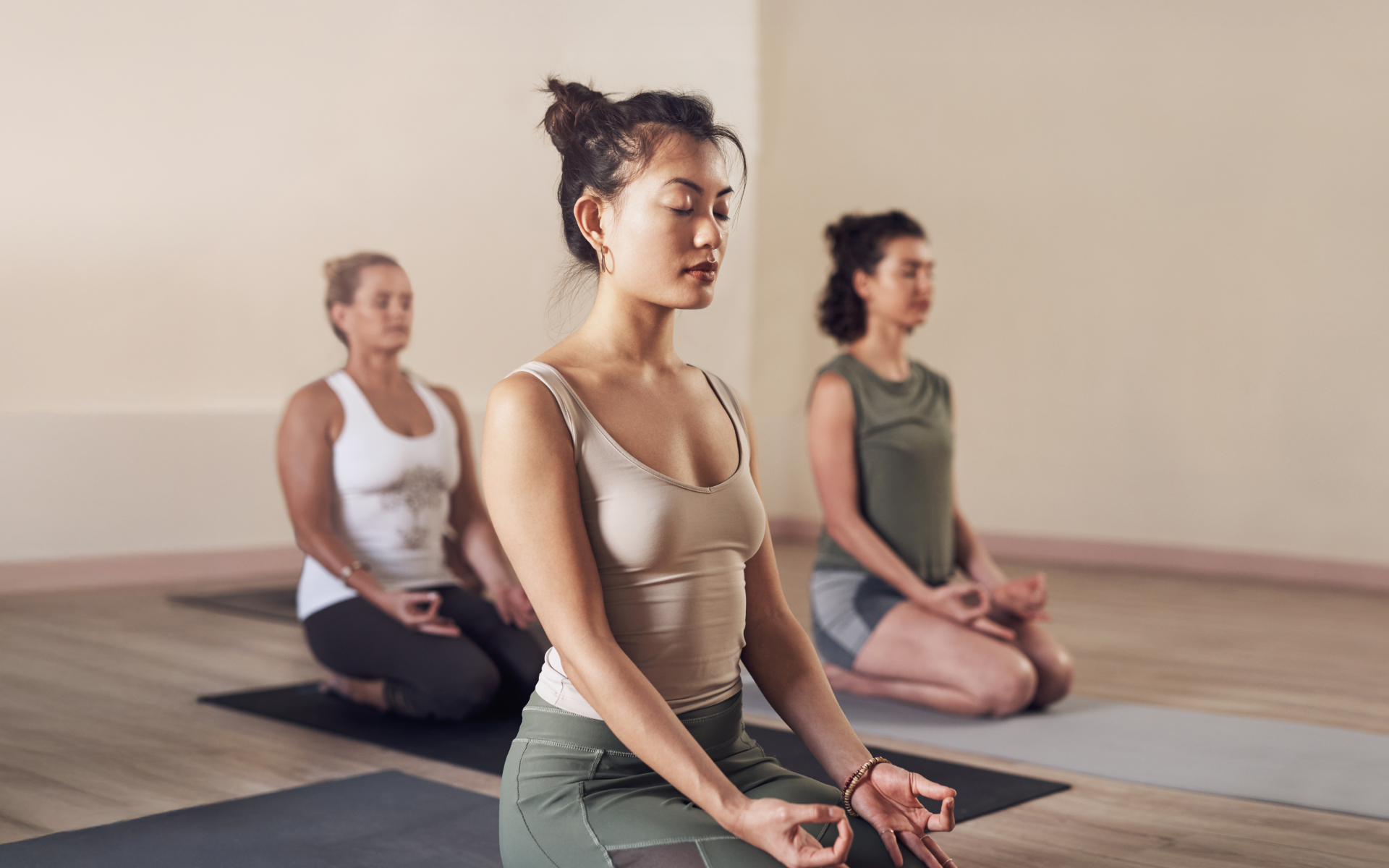A common belief in the fitness world states that we must break a sweat to reach our goals, be it weight loss or muscle gain. Somatic exercises present a completely different idea. They prioritize slow, mindful movements that don’t push your physical or mental boundaries. Instead, they circulate the idea of listening to your physical sensations and responding to them. These aren’t mere empty beliefs and deep research has proven how somatic exercises can increase strength and relieve pain (1).
When it comes to exercise plans, there could be some gender differences that should be considered. Although most exercises suit all genders, some routines may work more in favor of one over the other. This happens due to discrepancies in physique, hormones, and stamina (3). This article focuses on somatic exercises for women. Starting with a detailed description of what is somatic exercise, and later followed by the steps to perform these on your own, this article may be the push you need to start your somatic journey!
What Are Somatic Exercises?
An article published in Frontiers in Psychology defined somatic exercises as a movement-based approach to understanding the internal body. They also help enhance the awareness of our internal sensations toward our external environment and the movement in space (4).
Somatic movement is about paying attention to how your body feels on the inside when you move, not how it looks on the outside. It’s about being aware of yourself and moving in good, relaxing, and natural ways. Imagine stretching slowly and gently without pushing yourself too hard or causing pain.
Do Somatic Workouts Really Work?
Somatic exercises are about paying close attention to how your muscles feel as you move. They focus on noticing tightness or tension you might ignore and then gently moving to release it. An article published in the Journal of Bodywork and Movement Therapies defined these as involuntary stretching of the soft tissues, particularly during transitions between cyclic biological behaviors (5). Simply put, it’s the natural way our muscles tighten and relax throughout the day, like stretching after waking up.
These exercises are used for relieving chronic pain as they can enhance body awareness and improve self-management symptoms (4). In fact, somatic therapies have been found to release the emotions stored in our bodies that are linked to experiencing a traumatic event. Our bodies can withhold emotions and not release them unless there’s a certain level of stimulation. For example, some women may have tight hips due to stored emotions (1). Somatic exercises to release trauma may help them deal with these feelings.
Even if you don’t have chronic pain or emotional tension, somatic exercise can still help you. It can improve your posture, strengthen your muscles, and even help with issues such as a tight pelvic floor. According to the Somatic Movement Center, somatic exercises help you build new muscle habits and change how your muscles react (2).
Regularly performing somatic exercises can help practitioners improve flexibility, strength, and balance. The movements that are included in somatic routines can lengthen the tight muscles and help weak ones gain some strength. With time, this can help reduce the risk of injuries and elevate your physical capabilities. Flexibility and mobility are important factors in fitness that can reduce injuries among athletes and older adults.
The US Department of Health and Human Services even includes flexibility exercises such as somatic movement in its recommended physical activity guidelines for Americans (6).
Finally, somatic bodywork encourages a person to live mindfully. When you tap into your body, you may understand that you cannot be defined by the thoughts that live in your mind. Focusing on internal awareness also helps you better understand yourself, which leads to a more mindful and purposeful approach to everyday life. This can improve your overall well-being and quality of life.
How Can I Do Somatic Therapy by Myself?
The hustle of daily life keeps most of us from working out. But this isn’t the case if you opt for somatic exercises. You can perform free somatic exercises at home, ranging from slow and mindful movements to more advanced movements.
There are many exercises you can learn. Below, we show you some exercises The Somatic Systems Institute categorized as essential somatic movements. Check them out!
Flatten and Arch
- Lie on your back with your knees bent.
- Slowly inhale while arching your lower back upward.
- Slowly exhale while flattening your lower back downward.
- Repeat 5-10 times (or less), focusing on slow and deliberate movements.
Arch and Curl
- Lie on your back with your knees bent and your hands interlaced behind your head.
- Slowly exhale while lifting your head and flattening your back.
- Slowly inhale while lowering your head and arching your back.
- Repeat 5-10 times (or less), focusing on slow and deliberate movements.
BetterMe: Meditation & Sleep app can help you transmute stress into serenity, pull you up from the doldrums, free your mind from the cares and worries of the world, quell racing thoughts and infuse you with tranquility! Start using it now and change your life !
Side Curl
- Lie on your left side, rest your head on your left arm, and bend your knees at 90 degrees.
- Extend your right arm over your head and place your hand near your left ear.
- Inhale: Slowly lift your right foot while using your right arm to lift your head slightly.
- Focus on the feeling of your waist and rib cage muscles engaging.
- Exhale: Slowly lower your foot and head back down.
- Repeat 3-5 times (or less) on the left side.
- Turn over and repeat on the right side.
Washcloth
- Lie on your back with your knees bent.
- Roll one arm down toward the floor while simultaneously dropping your knees toward the same side.
- Turn your head in the opposite direction, creating a gentle spinal twist.
- Slowly roll your other arm down and drop your knees toward that side, turning your head in the opposite direction again.
- Repeat 3-20 times (or less), focusing on slow and relaxed movements.
Seated Twists
- Sit with your right hand on your left shoulder, knees bent toward the left.
- Gently rotate your torso to the left three times (or less).
- Hold your torso in the left position, then slowly turn your head to the right and back three times (or less).
- Now, turn your torso and head in opposite directions three times (or less) for a full spinal twist.
- Keeping your torso to the left, slowly lift your chin toward the ceiling, then lower your eyes towards the floor. Repeat three times (or less).
- Repeat all steps on the other side.
- Focus on slow and deliberate movements throughout.
In addition, somatic therapies such as somatic experiencing (SE) therapy use mind-body connections to deal with symptoms that are related to certain mental health conditions. This body-oriented approach has gained popularity for its ability to help individuals tackle trauma. In addition to somatic exercises for releasing trauma, there are also some somatic exercises for weight loss. You can explore various kinds of moves according to the goals you want to achieve.
Read more: Somatic Healing Techniques: A Holistic Approach to Physical and Emotional Recovery
Can You Lose Weight with Somatic Exercises?
Yes, you can!
Any movement that increases your heart rate and strengthens your muscles can trigger your body to burn calories. Somatic release is considered a sustainable form of exercise. Moving with purpose and paying attention to how your body reacts can make each movement more effective. As most somatic exercises are gentle and focus on listening to your body’s signals, they’re usually safer than traditional exercises.
Losing weight is more of a mental game. People must adopt healthy habits when they want to reach a healthy weight. Acts such as improving sleep and reducing stress factors can keep your cortisol levels under control (8). You may experience less pain, better flexibility, and more strength when combined with the physical benefits of somatic movements.
As a part of this program, you should talk to somatic specialists. Discuss customized programs according to your age and gender. For example, you can ask about somatic exercises for women over 40 or for women over 50 to ensure you follow a plan that suits your physique.
Whether you want to learn how to exit the spiral of self-harming behavior, overcome anxiety, cure insomnia or simply give yourself the time and space to bliss out and soak up the moment of complete peace and quiet – BetterMe: Meditation & Sleep app is exactly the tool for that ! If you don’t take care of number one, who will?
FAQs
How do I start somatic exercise?
Start by exploring the movements that feel good for your body. Try focusing on your breath and your internal sensations. You can also try simple stretches or guided somatic exercises online or in a class. Don’t forget to listen to your body and adjust the pace accordingly.
What is an example of a somatic practice?
An example of somatic practice is the body scan meditation. You must lie down in this practice and direct your attention to different body parts, paying attention to the sensations without judgment. This can cultivate body awareness and release tension.
Is tai chi a somatic exercise?
Tai chi is considered a somatic exercise that involves slow, mindful movements and focuses on internal awareness and sensation. However, it also covers elements of Chinese meditation and martial arts.
Is Pilates a somatic exercise?
Pilates is not traditionally classified as a somatic exercise, but it does include somatic principles such as slow and mindful movements. Like tai chi, Pilates can be practiced by focusing on physical fitness and building strength. Whether Pilates is somatic depends on the instructor’s approach and the practitioner’s focus during the practice.
The Bottom Line
Somatic exercises bring a unique and empowering approach to fitness. Women can discover a path to greatness, better health, and happiness by incorporating somatic exercises into their routines. Don’t forget that you should opt for a holistic fitness approach, regardless of your workout plan. So, if you perform somatic exercises for women, you should also work on other factors such as a balanced diet and better sleep patterns.
This article has covered some of the basics you should know as a beginner on the somatic pathway. If you find yourself stuck somewhere and can’t find the right movements, it’s always best to seek professional help. A customized plan and insightful guidance can help you feel better and hit your fitness goals.
DISCLAIMER:
This article is intended for general informational purposes only and does not serve to address individual circumstances. It is not a substitute for professional advice or help and should not be relied on for making any kind of decision-making. Any action taken as a direct or indirect result of the information in this article is entirely at your own risk and is your sole responsibility.
BetterMe, its content staff, and its medical advisors accept no responsibility for inaccuracies, errors, misstatements, inconsistencies, or omissions and specifically disclaim any liability, loss or risk, personal, professional or otherwise, which may be incurred as a consequence, directly or indirectly, of the use and/or application of any content.
You should always seek the advice of your physician or other qualified health provider with any questions you may have regarding a medical condition or your specific situation. Never disregard professional medical advice or delay seeking it because of BetterMe content. If you suspect or think you may have a medical emergency, call your doctor.
SOURCES:
- Emotions Might Be Stored in Your Hips—Here’s How To Release Them (2022, theeverygirl.com)
- How to Retrain Your Proprioception and Posture (2022, somaticmovementcenter.com)
- Gender Differences in Exercise Habits and Quality of Life Reports: Assessing the Moderating Effects of Reasons for Exercise (2014, ncbi.nlm.nih.gov)
- Moving With Pain: What Principles From Somatic Practices Can Offer to People Living With Chronic Pain (2020, pubmed.ncbi.nlm.nih.gov)
- Pandiculation: nature’s way of maintaining the functional integrity of the myofascial system? (2011, pubmed.ncbi.nlm.nih.gov)
- Physical Activity Guidelines for Americans (2019, health.gov)
- Somatic experiencing – effectiveness and key factors of a body-oriented trauma therapy: a scoping literature review (2021, ncbi.nlm.nih.gov)
- Tips to Reduce Cortisol Levels and Dial Down Stress (2024, health.clevelandclinic.org)









